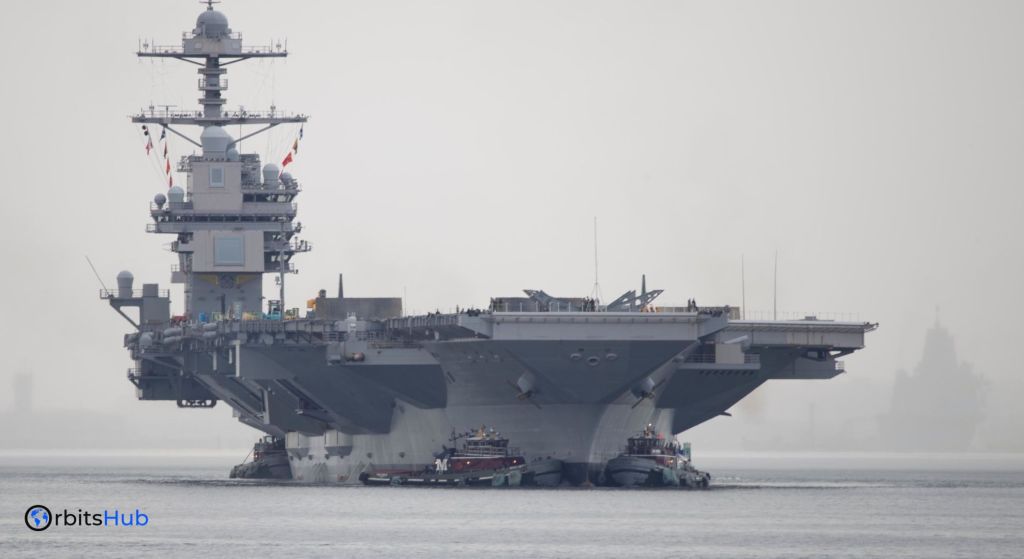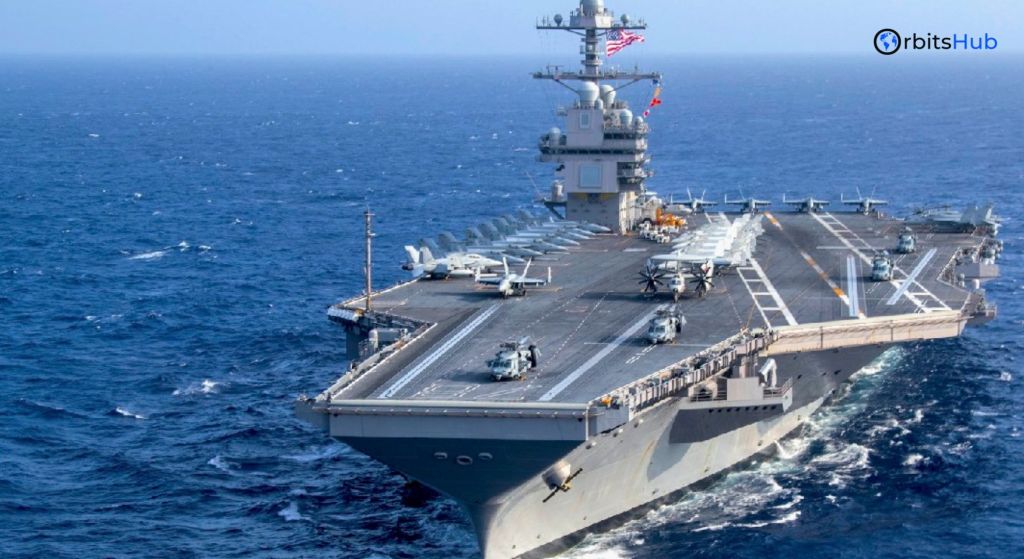Imagine a colossal vessel, a floating city traversing vast oceans, carrying a formidable arsenal of fighter jets, helicopters, and military personnel. An icon of naval might and technological wonder, this is not a scene from a science fiction film; it is the actuality of the biggest aircraft carrier in the world. This blog dives into the behemoth that reigns supreme on the world’s seas, exploring its features, capabilities, and significance within the global maritime landscape.
Unveiling the Champion: The Gerald R. Ford Class
As of December 2023, the world’s biggest aircraft carrier title belongs to the Gerald R. Ford-class carriers of the United States Navy. These technological marvels boast several impressive features:
- Massive Dimensions: The Gerald R. Ford-class carriers are behemoths, stretching over 337 meters (1,107 ft) in length and displacing approximately 100,000 tons at full load. This immense size allows them to carry a large air wing, extensive weaponry, and a crew of over 4,500 personnel.
- Nuclear Power: Unlike conventionally powered carriers that rely on fossil fuels, the Gerald R. Ford class utilizes atomic propulsion. This offers several advantages, including unlimited range, greater operational flexibility, and reduced reliance on fuel resupply.
- Advanced Technologies: There are many cutting-edge technologies in these carriers. For example, a new electromagnetic aircraft launch system (EMALS) makes takeoffs faster, advanced arresting gear makes landings safer, and a next-generation reactor design makes them safer and more efficient.
Capabilities and Advantages of the Biggest Aircraft Carrier
The sheer size and advanced features of the Gerald R. Ford-class carriers translate into several key advantages:

- Power Projection: These carriers are floating airbases, enabling the US Navy to project worldwide power and influence. Their ability to carry many aircraft allows them to conduct long-range missions, deter potential threats, and maintain a strong presence in critical regions.
- Enhanced Operational Flexibility: The nuclear propulsion system and advanced technologies onboard these carriers provide unmatched operational flexibility. For long periods, they can stay at sea without refuelling. This lets them respond quickly to new threats and continue working in remote areas.
- Future-Proof Design: The Gerald R. Ford class is designed to accommodate future advancements in naval aviation. Its spacious flight deck and hangar can house a broader range of aircraft, including next-generation fighter jets and uncrewed aerial vehicles (UAVs).
Beyond Size: The Significance of the Biggest Aircraft Carrier
The title “biggest” isn’t the only factor that makes the Gerald R. Ford class significant. Here’s why these carriers hold strategic importance:
- Symbol of Naval Supremacy: The presence of these behemoths on the world’s oceans underscores the United States’ position as a leading naval power. They serve as a deterrent to potential adversaries and a reassurance to allies.
- Force Multiplier: Aircraft carriers act as force multipliers, significantly amplifying the US Navy’s capabilities. Their ability to project airpower from a mobile platform extends the reach and effectiveness of other naval vessels in a carrier strike group.
- Technological Innovation: The development and deployment of the Gerald R. Ford class represent a significant leap forward in maritime technology. The lessons learned and technologies tested on these carriers will pave the way for future warship design and construction advancements.
Rivals on the Rise: Challengers to the Biggest Aircraft Carrier Title

While the Gerald R. Ford class currently reigns supreme, other nations are developing advanced aircraft carriers that could potentially challenge its dominance in the future:
- China’s Aircraft Carrier Ambitions: China has launched its third aircraft carrier, the Fujian, and is reportedly developing even larger carriers in the future. These changes could change the balance of military power in the Asia-Pacific area.
- Future US Innovations: The US Navy is already planning the next iteration of aircraft carrier design, the Next-Generation Aircraft Carrier (NGAC). These future carriers could incorporate even more advanced technologies and surpass the capabilities of the Gerald R. Ford class.
The race to build the biggest aircraft carriers reflects the evolving geopolitical landscape. The advanced capabilities of these carriers highlight the growing importance of naval power projection.
A Glimpse into the Future of Aircraft Carriers: Adaptation and Evolution
As technology changes, aircraft carriers will change how they look and what they can do to meet new obstacles. Here are some potential areas of focus:
- Integration of Unmanned Systems: Uncrewed aerial vehicles (UAVs) and uncrewed combat aerial vehicles (UCAVs) might play a more significant role in naval warfare in the future. Aircraft carriers could be adapted to accommodate these unmanned platforms’ launch, recovery, and operation.
- Directed Energy Weapons: Directed energy weapons, including high-powered lasers and railguns, are being considered for use in naval defense. Aircraft carriers could be outfitted with these systems to boost their defensive abilities.
- Artificial Intelligence (AI): AI could play a significant role in future aircraft carrier operations. It could optimize launch and recovery procedures. Also, it could streamline decision-making processes.

Continuous advancements in these and other emerging technologies likely shape the future of aircraft carriers.
A Titan of the Seas with a Global Impact
The USS Gerald R. Ford-class carriers stand as testaments to human ingenuity and engineering prowess. Their immense size, advanced features, and unmatched capabilities contribute to the United States’ dominant position on the world’s oceans.
Are you intrigued by the complexities of naval operations and global maritime strategy? OrbitsHub, a leading marine and aviation consultancy, can be your guide. Our team of experts knows a lot about the marine industry and can give you helpful information about different areas of military technology, global trade, and changes in geopolitics. Explore OrbitsHub to learn more about how OrbitsHub can assist you in navigating the ever-evolving maritime landscape.
FAQ’s
1. What is the biggest aircraft carrier in the world?
The most significant aircraft carrier in the world is the Gerald R. Ford-class aircraft carrier.
2. How large is the Gerald R. Ford-class aircraft carrier?
The Gerald R. Ford-class aircraft carrier measures approximately 1,106 feet (337 meters) in length, making it the largest aircraft carrier ever built.
3. Which country operates the Gerald R. Ford-class aircraft carriers?
The United States Navy operates the Gerald R. Ford-class aircraft carriers.





